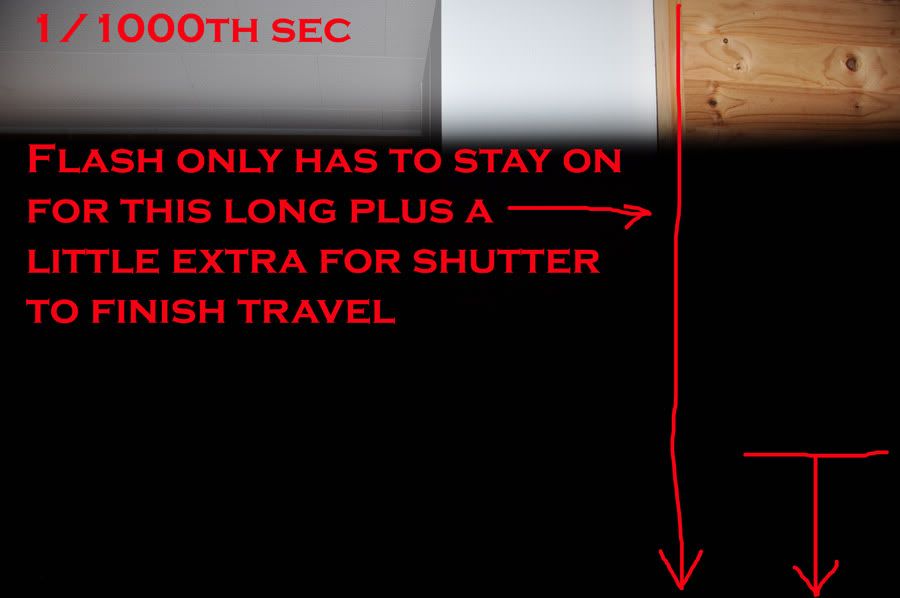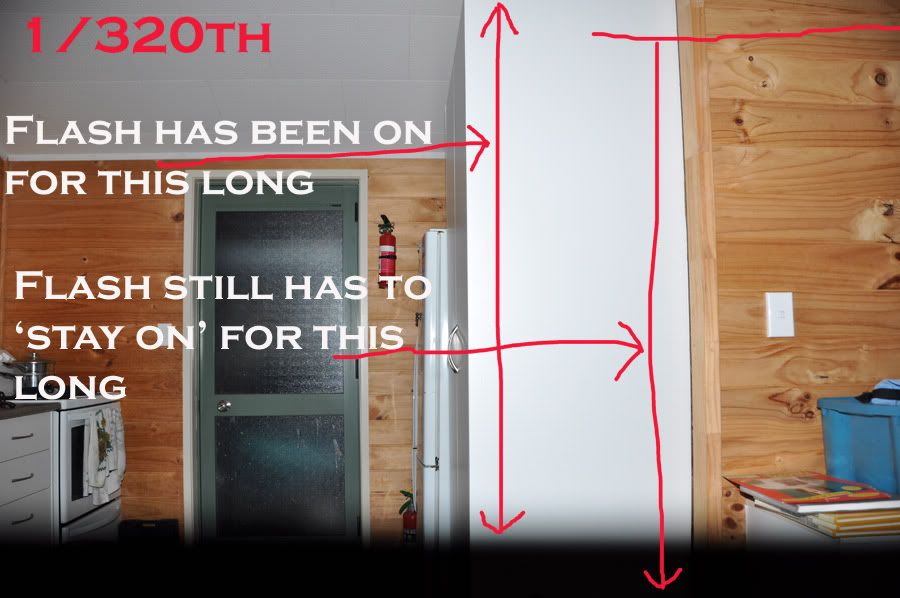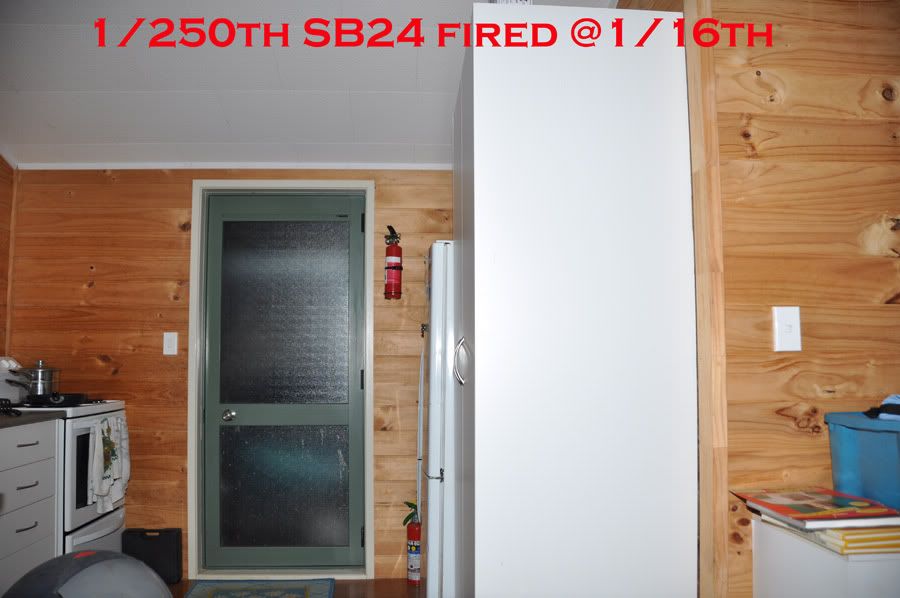The apertures shown here are not important , they are just the settings I used to do my tests and maintain a constant ambient exposure to compare the difference in working distance at different shutter speeds .
The shutter speeds shown should show the same pattern though .

Nikon's manuals don't explain auto 'high'- fp very well - or the limitations involved .
Most cameras have a focal plane shutter , except the D1 , D40 , D50 and D70[S] , they have electronically switched sensor/shutters and can do what I call
and effectively have 6X as much power with flash at maximum speed , compared to a pro body in high-fp mode } , but other cameras need high-fp mode .
<br />
At your camera's maximum synch speed [ 1/200th sec for the D90 ] the shutter opens , the flash fires , and the shutter closes , which means that the entire sensor gets the full flash .
Here's an older camera with a 1/90th sec synch speed ...

As the shutter speed increases the " first curtain " of the shutter opens and the " second curtain " starts chasing it across the screen right after it starts moving which means that a slit slides across the screen . If the flash were to fire at a higher shutter speed than the maximum synch speed you will get a partially-lit photo .....

As you can see in the above image the flash fired , it lasted about 1/10 000th sec and turned off - the slit was still in the beginning stages of its travels though and so only a slit has been lit , as the slit continues its journey with no light source the top of the image will be black .
The solution is for the flash to act as a ' continuous ' light , it fires rapidly in succession and may fire tens of thousands of times per second , and so is effectively a 'continuous ' light and behaves the same as the ambient with regard to the fact that shutter speed now controls the flash output as well as the ambient .
It would look something like this in slow motion - as the slit slides across the frame the flash keeps firing .... bzzzzzzzzzzzzzz








This is an old Canon camera so it is not exactly what the Nikon shutter would look like but it conveys the general idea . The main trade-off being that a lot of light is being wasted on the back of the partially open shutter .
To do the maths you simply need to put your SB800 on the camera and assume 'sunny 16' rule - for the brightest clearest day you could have - at iso 200 and 1/200th you would be at F16 - set it to that , it's a " worst case scenario ' for outdoor flash .
Now have a look at the working distance shown on the back of the flash with the flash head facing forward , we have :
1.) 18mm 8.8 feet .
2.) 35mm 11 feet .
3.) 105mm 17 feet .
Now when we keep the ambient exposure where it is we can assume that changing to F8 will let in 4 X as much light so we would have to go to 1/800th sec shutter speed which is high-fp mode .
This gives us :
1.) 18mm 4.6 feet
2.) 35mm 5.8 feet
3.) 105mm 8.8 feet .
The calculations :
1.) 4.6/8.8 = 0.522 X the distance .
2.) 5.8/11 = 0.527 X the distance .
3.) 8.8/17 = 0.517 X the distance .
The D90 has a synch speed of 1/200th and @ 105mm zoom ....
I kept adjusting my settings for an equally exposed ambient and got these results :
F20 iso 200 1/125th = 4.0, working distance
F18 iso 200 1/160th = 4.5m
F16 iso 200 1/200th = 5.0m
F14 iso 200 1/250th = 2.7m
F13 iso 200 1/320th = 2.7m
F11 iso 200 1/400th = 2.7m
F10 iso 200 1/500th = 2.7m
We see the pattern change with auto-fp where the flash starts to behave like a continuous light source and the working distance stays the same .
I just recorded the assumed working distance that the SB800 reported without actually doing any tests to see how much power it had but the distance of 2.7m as opposed to 5.0m suggested slightly more than 1/4 power available than normal flash mode .
It seems though that many are reporting less than that so I wonder where the error lies ?
So that means that we have just over half the working distance in each situation when we keep the ambient exposure where it is . To confirm this we can go to F4 , let in 4 X as much light , and to keep the ambient where it is we will have to go to 1/3200th sec effectively cutting that 4 X as much light in 1/4 again and negating the " advantage ' of opening the aperture .
So now the flash is behaving the same as continuous light and whatever we do , keeping the ambient correctly exposed , we will have that same working distance .
Because of the 'inverse square law' [ 2 X the distance needs 4 X the power , while 1/2 the distance only needs 1/4 the power ] .

When the subject is twice as far the lengths of the sides doubles , 2 X 2 = 4 X the area .
And of course halving the distance means you will only need 1/4 the power .
Once again it's not all that simple . The distances shown are with regard to the flash having to light the entire scene , something we don't need when we have the ambient correctly exposed .
A common setting for those who use 'fill-flash' outdoors is TTL-1.7 compensation , just to add some light to the subject without overpowering it with flash .
TTL flash doesn't know how well you have the ambient exposed and negative compensation will need to be dialed in . TTL/BL on the other hand takes the ambient exposure into account and if it detects correct exposure it will automatically dial itself back to the equivalent of TTL-1.7 in situations where they meter equally .
Many people will dial in even more negative compensation so if you had to assume an 'average' of -2 EV for the flash compensation that is two stops , or 1/4 the power that you are 'demanding' of the flash anyway so it will be able to do that at the first distance suggested by the flash head before you changed to high-fp mode .
If you were in TTL mode and went to high-fp , at105mm , and shot a subject 17 feet away [ when the flash head tells you that your limit is 8.8 feet ] the flash head will probably register -2 after firing telling you it never had enough power .
But if you have dialed in '-2' on the flash head it will be happy to light a subject 17 feet away because it can do that at '-2' :) .
This afternoon I did some tests to compare the power of auto-fp to normal flash . I used a solid white wall and kept the flash set at 1/1 full power and also made sure I kept the ambient level [which was very under-exposed ] the same , to simulate a situation where we would keep our ambient settings in the same place while reverting to auto-fp mode .
I aimed to get the same histogram in each shot and it was interesting how much difference a few cm made when I made adjustments .
This is what I aimed for :

After each change in settings I moved the camera until I got the same histogram and then measured the distance to the flash head so I could calculate the power difference compared to normal flash .
F25 1/200th normal flash 195cm
F22 1/250th auto-fp mode 68cm = 1/8th of normal flash power
F16 1/500th 88cm = 1/5
F11 1/1000th 120cm = 1/2.6
F8 1/2000th 136cm = 1/2
F6.3 1/3200th 120cm = 1/2.6
F5.6 1/4000th 112cm = 1/3
did similar tests where he maintained a constant distance and measured the difference using the histogram and has kindly allowed me to use his results here .

He then did a test with ambient only and compared the results to make sure it wasn't the shutter that was causing the variation .

My conclusion is that due to the way auto-fp works even though the flash head suggests the same working distance at any of these settings when in auto-fp mode it appears that the combination at 1/2000th sec yields the greatest output , after which the curve drops off again .
Since auto-fp flash behaves as a continuous light the slower the speed the more energy it requires ! So faster shutter speeds mean that light is 'switched on' for shorter times , not counting the short period before the shutter opens and after it closes that it will need to be on . This will result in faster charge times .
In other words , when you revert to auto-fp mode stay away from the slower speeds and aim for 1/2000th sec and the aperture that gets you the results you want to get the most flash power possible in this mode .


Ok well I've been doing more tests and calculations on the subject to try and figure out why we lose so much power as we start going into auto-fp mode and think I just worked it out .
Auto-fp flash logically must stay on for longer for slower shutter speeds .
Let's take 1/1000th sec first , the flash must start 'pulsing' before the first curtain opens - then it must last for 1/280th sec [ if that's how fast the curtain moves ] but once the first curtain reaches the other side it must stay open for the duration of the slit that still has to close !
At 1/1000th sec let's say that slit is 1/4 of the frame = another 1/1120th of a second.

Now we look closer at the slit at speeds closer to normal sync .
1/320th shows a much larger slit [ 3X the size of 1/1000th?]
Now after the first curtain moves across the frame [ 1/280th sec] the flash still has to remain on until the second curtain is closed which will now take 3X as long as at 1/1000th = 3/1120th = 1/370th sec extra !
This would explain why the first drop into auto-fp mode gives us so much less power than 1/2000th .
When I fire the SB24 at 1/16th on the D90 at 1/250th sec I don't see the curtain starting to close yet though sync speed is back at 1/200th .
This means that when the flash goes into fp mode it is doing so over 1/280th sec plus the 1/250th sec that the rear curtain takes to close cutting the total power in half [approximately ] .
So auto-fp would have to push out around half as much power over twice the time as opposed to around 1/250th sec shutter travel at 1/4000th sec - not counting the power before and after the pulse .

So essentially different shutter speeds would vary how long auto-fp stays on , and how much power it pushes out over that time period resulting in the differences we see between 1/250th and 1/2000th in auto-fp mode !
.
<!-- amazon_ad_tag = "bestofthephot-20"; amazon_ad_width = "728"; amazon_ad_height = "90";//-->
